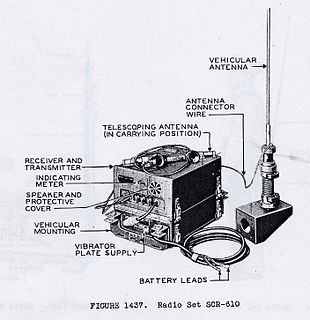
The AN/ARC-5 Command Radio Set is a series of radio receivers, transmitters, and accessories carried aboard U.S. Navy aircraft during World War II and for some years afterward. It is described as "a complete multi-channel radio transmitting and receiving set providing communication and navigation facilities for aircraft. The LF-MF-HF components are designed to transmit and receive voice, tone-modulated, and continuous wave (cw) signals." Its flexible design provided AM radiotelephone voice communication and Modulated continuous wave (MCW) and Continuous wave (CW) Morse code modes, all of which are typical capabilities in other Navy aircraft communication sets of the period. It was an improvement of the Navy's ARA/ATA command set. Similar units designated SCR-274-N were used in U.S. Army aircraft. The Army set is based on the ARA/ATA, not the later AN/ARC-5. The ARA/ATA and SCR-274-N series are informally referred to as "ARC-5", despite small differences that render all three series incompatible. Like the AN/ARC-5, the ARA/ATA and SCR-274-N had AM voice communication and two-way MCW and CW Morse code capability.

The SCR-284 was a World War II era combination transmitter and receiver used in vehicles or fixed ground stations.

Signal Corps Radios were U.S. Army military communications components that comprised "sets". Under the Army Nomenclature System, the abbreviation SCR initially designated "Set, Complete Radio", but was later misinterpreted as "Signal Corps Radio."

The SCR-299 was a U.S. Signal Corps mobile military communications unit used during World War II.
The SCR-197 was a ground mobile high frequency radio station used by the U.S. Army Signal Corps prior to and during World War II, notably the Battle of Wake Island in 1941.
The AN/MPN is a mobile Ground-controlled approach radar first used during World War II. "MPN" is Joint Electronics Type Designation System nomenclature for (Ground) Mobile (M), Pulsed (P), Navigation aid (N).

The SCR-694 was a portable two way radio set used by the U.S. military during World War II.
The K-34 trailer was used by the U.S. Army Signal Corps to house electronic equipment, during and after World War II.
The K-35 trailer was a house trailer used by the U.S. Army Signal Corps during and after World War II.
The K-55 trailer, manufactured by the A. J. Miller and Oneonta Linn Corp, was a house trailer used by the U.S. Army Signal Corps during and after World War II.
The K-72 trailer, manufactured by the A. J. Miller, was a house trailer used by the U.S. Army Signal Corps during and after World War II.
The SCR-203 was a U.S. Army radio transceiver used during World War II and designed to be mounted on an animal pack saddle.

The low-frequency radio range, also known as the four-course radio range, LF/MF four-course radio range, A-N radio range, Adcock radio range, or commonly "the range", was the main navigation system used by aircraft for instrument flying in the 1930s and 1940s, until the advent of the VHF omnidirectional range (VOR), beginning in the late 1940s. It was used for en route navigation as well as instrument approaches and holds.
The radio set AN/CRN-2 was an air transportable glide path transmitter used by the Army Air Force during and after World War II, the set was standardized on 5 February 1944. and was an upgrade of SCR-592.
The AN/MRN-1 was an instrument approach localizer used by the Army Air Force during and after World War II. It was standardized on 3 July 1942. It replaced the SCR-241, and was a component of SCS-51.
The AN/MRN-3 was a marker beacon set used by the Army Air Force during and after World War II, it was standardized 23 October 1943, and replaced SCR-241.

The SCR-610 was a Signal Corps Radio used by the U.S. Army during and after World War II, for short range ground communications, it was standardized 29 Sept. 1941,

The AN/MRN-2 was a Radio Range set used by the Army Air Force during and after World War II, it replaced in part the SCR-277.

The SCR-245 Radio was a mobile MF/HF Signal Corps Radio used by the U.S. Army before and during World War II, for short range ground communications, It was one of the first crystal controlled sets used by the Army.









